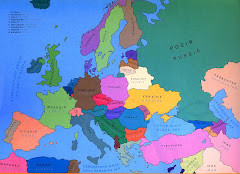
 The exterior of the Egyptian Museum is beautiful. We couldn't take any photos inside, so here are a few flikr photos, including King Tut's elegant gold mask, from the Egyptian Museum.
The exterior of the Egyptian Museum is beautiful. We couldn't take any photos inside, so here are a few flikr photos, including King Tut's elegant gold mask, from the Egyptian Museum.The Egyptian Museum is a journey back through 5000 years of history, a vast warehouse of artifacts from ancient times.The building itself is beautiful, rosy, elegant, and finely detailed. We could see it from the windows of our hostel. Large high-ceilinged rooms hold tons upon tons of items excavated from the sands of time by fascinated scientists and archaeologists going back at least to Grecian times and up to the present. Egypt is, obviously, an
 archaeologist’s dream.
archaeologist’s dream.I've never seen so many mummies’ coffins or sarcophaguses in one place anywhere, room after room after room. The designs and colors and decorative paintings are as varied as any artist’s palette and inspiration, and they fascinate. Hiereoglypics, symbols, and images of ancient Egypt. Some look as bright as the day they were painted over 3000 years ago; some are faded into antique pastels, a muted but persistent glory.
The jewelry is beautiful, too, gold, precious stones, and bead work in amazing detail, supreme craftsmanship, and abundant. Bejeweled Egyptian queens must have dazzled their pharoahs.
There was no end to the splendors. I spent two hours in the galleries featuring items from King Tut's tomb, and I didn’t come close to seeing it all. I've never seen so many little carved animals, statuettes, art work, finely crafted furniture, gilded gold chairs with ornate carvings fit for the young king who occupied them. How could a tomb hold so many things? It must have been like the Grand Bazaar of Egypt in a mausoleum: so extravagant a setting for a dead king that could never enjoy his grand furnishings as much as we do today!
The Museum sometimes seemed more like a storage area than a museum. I would have liked more information, more explanation of what I was seeing. Perhaps some information sheets or brochures at the entrances to the various exhibits. I think there's been some improvement in how the items are displayed and the Museum continues to refine its exhibits.
One thing the Museum has mastered: it has a fantastic gift shop. It was nice to come upon it at the end of the visit, along with a nice café and a good cup of coffee. I bought lots of little gifts for family and friends, delighted that every item in the shop had a price tag. That alone warranted a grand shopping spree.
When we started out in the morning Jud and I thought we'd make it to the Coptic museum this day, too, but after several hours we hadn't even begun to cover the Egyptian Museum. Jud stayed to sketch, and I went back to the hostel to reflect and write.
An overwhelming melange of images came to my mind as I stopped to think about how to describe the experience. Sometimes words fail me. Then again, Jud and I both went through the same museum and saw most of the same things, and yet when we talked about it at dinner (at a great Egyptian restaurant) his experience and mine were very different.
Travel adventures are, in this sense, subjective and personal. They are memories made by what you see, and how what you saw made you feel. Memories mixed with emotions, reality with imagination, experience with dreams. The Egyptian Museum encompasses all of these, a magic carpet ride back in time to the kingdoms of the great pharoahs of Egypt.







 me out of it!
me out of it! want to know if any fertilizer or other stuff has been added to the ground or fed to the animals. Tonya assured all customers the pigs were well fed with only the best food. I myself fed apples and corn to those little pigs, and to the big fat ones too, along with handfuls of fresh grain.
want to know if any fertilizer or other stuff has been added to the ground or fed to the animals. Tonya assured all customers the pigs were well fed with only the best food. I myself fed apples and corn to those little pigs, and to the big fat ones too, along with handfuls of fresh grain.












 was the day the library called me at 12:30 to say I must be there at 1:30 to celebrate the 10th anniversary of poet Ivan Savich's death. I sympathized. "Yeah, I've been to plenty of those meetings, looking a wreck and not understanding much to boot." I used the analagy of being a plain Amerikanka at a Ms. Universe contest. We laughed knowingly at the image.
was the day the library called me at 12:30 to say I must be there at 1:30 to celebrate the 10th anniversary of poet Ivan Savich's death. I sympathized. "Yeah, I've been to plenty of those meetings, looking a wreck and not understanding much to boot." I used the analagy of being a plain Amerikanka at a Ms. Universe contest. We laughed knowingly at the image. 






























